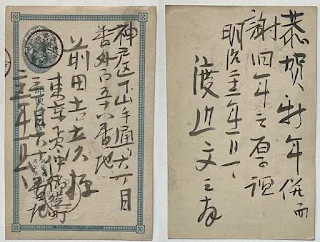These seven postcards, all addressed to Maeda Yoshihiko (前田吉彦) in Kobe, represent an exceptionally rare surviving correspondence between Western-style painters of the Meiji period. As a prominent yōga (Western-style) artist himself, Maeda maintained professional ties with several key figures in Japan's evolving art world of the 1880s. These cards—likely the only such collection in existence—form an interconnected web of artistic exchange, each shedding light on the relationships, movements, and creative discussions among painters during this transformative era.
Watanabe alternated between multiple name variants in his correspondence: 渡辺文三郎 (Watanabe Bunzaburō), 渡辺文三 (Watanabe Bunzo), 渡辺薇三 (Watanabe Bizan). He also referenced other artists, including: 内田茂八 (Uchida Mohachi) and his school (内田茂八門), 山名迂介 / 山名迂助 (Yamana Usuke), 増田松之 (Masuda Matsuyuki).
Chronological Correspondence of Watanabe Bunzaburō
1. December 31, 1888
Sender’s Name: 渡辺文三郎 (Watanabe Bunzaburō)
Postmark: 下谷東京 (Shitaya, Tokyo)
Return Address: 東京下谷中御徒町3丁目68番地 (3-68 Naka-Okachimachi, Shitaya, Tokyo)
Content: A New Year’s greeting card, placing Watanabe in the vibrant cultural district near present-day Ueno Park—within walking distance of Asakusa, where Goseda Hōryū (五姓田芳柳) maintained his influential art studio. This strategic location connected Watanabe to Tokyo’s bustling ukiyo-e and Nihonga circles during the Meiji era’s artistic renaissance.
2. April 1889
Sender’s Name: 渡辺薇三 (Watanabe Bizan) – an artistic pseudonym
Return Address: 東京下谷中御徒町3丁目68番地 (3-68 Naka-Okachimachi, Shitaya, Tokyo)
Addressee: 六要堂 (Rokuyōdō—likely Maeda Yoshihiko’s art studio or school)
Content: Watanabe informs Maeda of shipping two artworks, apologizing for both the delay and his late reply. While the contents of these lost paintings remain unknown, this card provides insight into the professional networks and creative exchanges among Meiji-era artists.
3. May 29, 1889Sender’s Name: 渡辺文三 (Watanabe Bunzo) – a rare informal variant
Postmark: 下谷東京 (Shitaya, Tokyo)
Return Address: 東京下谷中御徒町3丁目68番地 (3-68 Naka-Okachimachi, Shitaya, Tokyo)
Content: This card highlights Watanabe’s connection to Meiji-era Tokyo’s art scene, situated between Ueno Park (a developing cultural hub) and Asakusa, where Goseda Hōryū’s studio thrived. The informal signature suggests either personal familiarity with Maeda or the casual nature of the correspondence.
4. June 18, 1889
Sender’s Name: 渡辺文三 (Watanabe Bunzo)
Postmark: Shitaya, Tokyo
Return Address: 東京下谷区西町24番地 (24 Nishimachi, Shitaya-ku, Tokyo)
Content: Watanabe informs Maeda that Yamana Usuke (山名迂介), a pupil of Uchida Mohachi (内田茂八), will be staying at Uchida’s Osaka residence (大阪北区中之島7丁目…). He also mentions fellow artist Masuda Matsuyuki (増田松之) and another unnamed associate, though their purpose remains unspecified.
5. July 29, 1889
Sender’s Name: 渡辺文三郎 (Watanabe Bunzaburō)
Postmark: Shitaya, Tokyo
Return Address: 東京下谷区西町24番地 (24 Nishimachi, Shitaya-ku, Tokyo)
Addressees: Both 前田吉彦 (Maeda Yoshihiko) and 増田松之 (Masuda Matsuyuki, 1862–1932)
Significance: This dual-addressed card underscores Masuda’s role as a bridge between traditional and Western art pedagogy in Meiji Japan. Trained under Takahashi Yuichi (高橋由一, the father of Japanese oil painting) and later Goseda Hōryū, Masuda’s hybrid artistic approach (Western realism + ukiyo-e traditions) made him a key yet understudied figure. The card suggests active professional networks among second-generation yōga painters during Tokyo’s rapid modernization.
Summary of Key Insights
Artistic Networks: These postcards reveal a web of connections between Watanabe, Maeda, Masuda, Yamana, and Uchida, illustrating the collaborative nature of Meiji-era yōga circles
Name Variations: Watanabe’s use of different signatures (文三郎, 文三, 薇三) reflects either shifting artistic identities or contextual familiarity.
Geographical Significance: His addresses in Shitaya placed him near key cultural hubs (Ueno, Asakusa), facilitating interactions with major artists like Goseda Hōryū.
Lost Artworks & Pedagogy: Mentions of shipped paintings and school affiliations (e.g., Uchida Mohachi’s studio) hint at undocumented artistic exchanges and training methods.
This collection offers an unparalleled glimpse into the personal and professional dynamics of Japan’s Western-style painters during a pivotal era in art history.





No comments:
Post a Comment